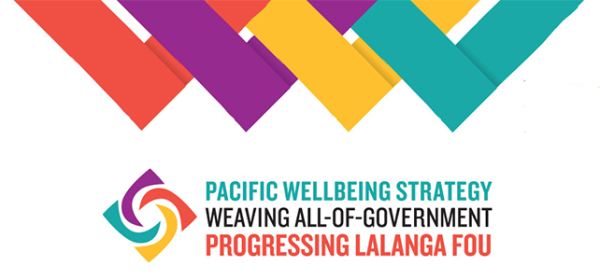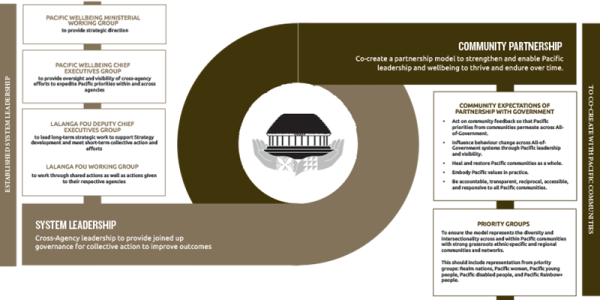All-of-Government Pacific Wellbeing Strategy
All-of-Government Pacific Wellbeing Strategy
Mai na matua, mo ki tatou, ki na fanau - Learning from yesterday, living today, and hope for the future
This alagakupu Tokelau guides the Strategy and urges us to learn from our ancestors, from past experiences, and through living today, to ensure hope for our families and the future.
The All-of-Government Pacific Wellbeing Strategy is the mechanism for a new way of working across government to improve wellbeing outcomes for Pacific peoples. It does this through four interconnected focus areas:
- Pacific values and principles – Lalaga Potu: that form the foundations of the Strategy.
- Partnership and governance – Fale Fono: to strengthen system leadership and establish genuine partnerships with Pacific communities to support Pacific wellbeing.
- Performance and improvement – Vaka Moana: to measure and monitor the impact of investment in Pacific communities through the All-of-Government Pacific Wellbeing Outcomes Framework that includes a set of Pacific wellbeing indicators and measures.
- Capability – Te Kupega: to build and strengthen cultural capability and engagement approaches across government.
Through these focus areas, the All-of-Government Pacific Wellbeing Strategy will lay enduring foundations to support Pacific wellbeing now and well into the future.
In November 2019, Cabinet agreed to “a new way of working through an All-of-Government Pacific Wellbeing Strategy". The Strategy will set the government’s strategic and implementation priorities for improving Pacific wellbeing outcomes that align to the Pacific Aotearoa Lalanga Fou Goals.
Refer SWC-19-MIN-0186 and CAB-19-MIN-0610
In September 2021, Cabinet approved the four rescoped focus areas for the All-of-Government Pacific Wellbeing Strategy in the form of: Pacific values and principles; Partnership and governance; Performance and improvement; and Capability
Refer SWC-21-SUB-0130 AND CAB-21-MIN-0384
In April 2022, Cabinet approved the completed All-of-Government Pacific Wellbeing Strategy and the next phase of implementation to co-design Pacific-specific wellbeing indicators and measures with Lalanga Fou agencies.*
Refer SWC-22-MIN-0051 and CAB-22-MIN-0104
The Government’s commitment to Pacific wellbeing continues to be an urgent priority. Hon Aupito William Sio, Minister for Pacific Peoples, said, “The Strategy establishes how we respond to the call [to action from Pacific communities in Lalanga Fou] to improve outcomes now, and well into the future.
"Pacific communities want a pathway to wellbeing that learns from the past and builds on success for the future. The Strategy’s values-based approach recognises Pacific communities as the owners of their cultures, identities and languages and must therefore lead decisions that affect their lives."
*Lalanga Fou Agencies:
Ministries for/of Pacific Peoples; Business, Innovation and Employment; Culture and Heritage; Education; Health; Housing and Urban Development; Social Development; Kāinga Ora; Oranga Tamariki; Te Puna Aonui; Treasury.
The Pacific Aotearoa Lalanga Fou report, released on 13 November 2018, presents a refreshed vision and set of four goals for Pacific communities living in Aotearoa. The report is the start of a conversation to better understand Pacific people’s contribution to Aotearoa's economy, and how we define success, prosperity and wellbeing. It lays a strong foundation that we can build upon for generations to come.
The development of the All-of-Government Pacific Wellbeing Strategy progresses the aspirations of Lalanga Fou to lay enduring foundations for Pacific communities to determine their own wellbeing outcomes, with Government contributing to them through its investment into policies and initiatives.
Minister Sio says he expects “...the four goals of Lalanga Fou guide and direct all joined up government investment that is determined by Pacific communities for Pacific communities. These goals will be the basis for enduring partnerships”.
The Strategy uses Te Pū, the Te Reo Māori Kūki ‘Āirani description of blowing the conch shell, to symbolise the call to action in Lalanga Fou.
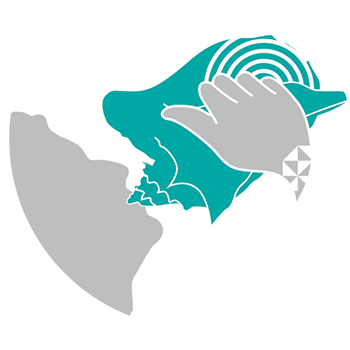
'Akatangi'ita te pū ei kāpiki'anga kite 'iti tangata - Blow and sound the conch as a call to our people.'
The All-of-Government Pacific Wellbeing Strategy weaves together and strengthens strategic leadership, advice, policies and programmes across All-of-Government so that we contribute to the aspirations of Pacific peoples and enable the vision and goals of Lalanga Fou to be achieved in a Pacific-centric way.
Lalanga Fou uses a combination of the Samoan and Tongan words “to weave” – lalaga fou and lalanga fo’ou respectively. These weaves are typically woven from left to right and top to bottom. Lalanga Fou provided initial strands for weaving into the Strategy. As we started our weave, however, we quickly realised the strands need to interconnect and retouch each other across the weave to ensure relevance and strength.
The Strategy uses the Niuean circular potu weave for the Strategy because it is seeking to weave together and strengthen All-of-Government. This is a complex weave that starts at the centre.
Read the Pacific Wellbeing Strategy Overview.
We have heard from Pacific communities that values are critical foundations of this Strategy. From our collective experience and knowledge, we know values must be used practically, evidenced, Pacific-specific and derived from engagement with communities.
The Strategy identifies baseline Pacific cultural values and principles to guide government on how to express Pacific values in practice:
Objectives of the Pacific cultural values and principles focus area
In September 2021, government endorsed a values-based approach; acknowledging that the skilful weaving of Pacific values, together with its commitment to embed them, will provide opportunities that directly enhance Pacific wellbeing.
We’ve heard from Pacific communities that this needs to include:
- working reciprocally with Pacific communities to:
- co-create values and principles to include the breadth of our multi-dimensional Pacific Aotearoa peoples and communities
- revitalise Pacific languages, cultures and identities
- develop authentic, contextualised information on values and principles for wellbeing in diverse communities
- make this information available to support behaviour change in government and ensure equity of access for our Pacific communities.
- setting high expectations for embedding Pacific values and principles, including how these should lead to behaviour change so that Pacific peoples and communities feel they belong, and are seen and heard
- building and improving system capability across All of Government to:
- increase understanding, use and capability of diverse Pacific knowledge, stories, worldviews, values, approaches and frameworks relating to Pacific wellbeing
- empower Pacific peoples to determine how their cultural knowledge, stories, worldviews, values, approaches, and frameworks are used
- improve cultural capability to engage and employ cultural diversity across government and build trust and effective relationships with Pacific peoples and communities.
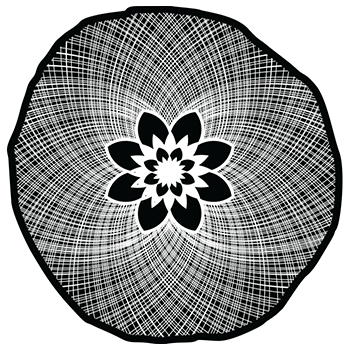
The ‘Potu’ is a Niue circular weave. It is a complex weave that starts at the centre. The Strategy has been built on ‘Lalanga Fou’ and calls for Pacific values to be embedded into government. We will see in our future that Pacific values lie at the heart of strategic leadership, policy design, and government programmes that impact Pacific people. Our Pacific principles will help guide Government to do so. Like the ‘Potu’, the success of the circular weave lies in the centre being strong.
Objectives of the Partnership and governance focus area
This focus area is a critical strategic opportunity. It supports system leadership, partnerships between All-of-Government and Pacific peoples, and identifies the supporting elements that will convert these arrangements into collective action.
Government systems leadership and governance
When we have enabling leadership and accountability, we can establish new ways for All-of-Government systems to work that can then, over time, be embedded across all government agencies and systems.
These are the current Ministerial and agency groups and their specific responsibilities and accountabilities for the All-of-Government Pacific Wellbeing Strategy:
Pacific Wellbeing Ministerial Working Group provides strategic direction for cross-agency collaboration and collective action.
Pacific Wellbeing Chief Executives provide oversight and visibility of cross-agency efforts to fast-track Pacific priorities in their individual agencies and across All of Government.
Lalanga Fou Deputy Chief Executives lead long-term strategic work to support Strategy development and implementation and to meet short-term collective act
ion and efforts.
Lalanga Fou Working Group works through shared actions as well as actions given to their respective agencies*.
*Lalanga Fou Agencies:
Ministries for/of Pacific Peoples; Business, Innovation and Employment; Culture and Heritage; Education; Health; Housing and Urban Development; Social Development; Kāinga Ora; Oranga Tamariki; Te Puna Aonui; Treasury.
Community leadership and creating a new way of working together as partners
Pacific peoples are the owners and leaders of their languages, cultures, and identities and their own wellbeing outcomes. Our role in All of Government is to deeply respect this and to partner in ways that enable Pacific leadership and ownership to thrive and sustain over time.
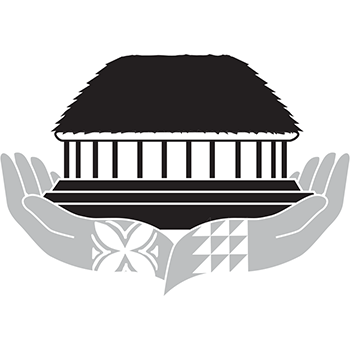
The open meeting house is where partnership and governance happens. It is round for a reason - everyone has an equal say. It is a space that, when entered, attendees have an understanding of protocol or are presented with a protocol that is safe and supports all in the room.
Objectives of the Performance and improvement focus area
We have the opportunity to transform the way agencies and communities work together to drive equitable wellbeing outcomes for Pacific peoples in Aotearoa, by:
- aligning what we do in government agencies to achieve common goals, in this case the Lalanga Fou goals
- measuring the impact of our collective efforts so that we achieve excellence for Pacific peoples and communities and that they benefit from equitable wellbeing outcomes, as well as increased return on investment for Government.
The Pacific Wellbeing Outcomes Framework
The Pacific Wellbeing Outcomes Framework is a tool to provide:
- A clear idea of where we want to get to (outcomes)
- A way of knowing if we are going in the right direction (alignment, measurement, and reporting)
- Making sure everyone is working together and accountable (monitoring, evaluation, and learning).
Vaka Moana represents all the elements required to ensure we can plan strategically, work collaboratively and iteratively to move ahead, to constantly monitor, evaluate and ensure improvements, if we are to reach our shores of the Lalanga Fou vision and Pacific wellbeing.
Read the Pacific Wellbeing Outcomes Framework Overview
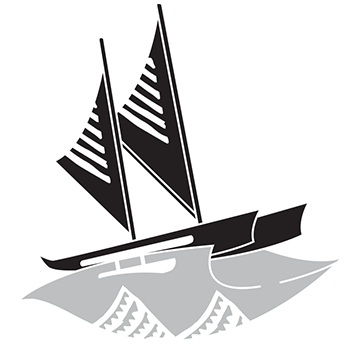
Navigational knowledge coupled with high performance technology like the large double-hulled craft ‘Kalia’ (Tongan) remain cutting edge today. Double hull ensures stability, speed and manoeuvrability. Kalia could carry many people, livestock, and provisions over vast distance.
Objectives of the Capability focus area
- To provide government with the tools to support building and improving Pacific cultural capability that respond to the needs of Pacific communities.
- To identify capability requirements for Pacific communities and groups through a co-creation process.
For the latter, we recognise and seek to coordinate with programmes and practices that are already in place.
See the Pacific cultural capability tools below:
Kapasa - The Pacific Policy Analysis Tool
Yavu - Foundations of Pacific engagement tool
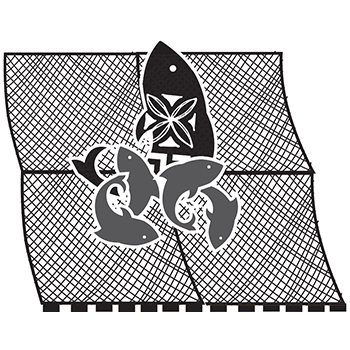
The art and science of fishing requires individuals and whole groups to learn layers of knowledge, to grow personal skill, and be informed by ancestral learnings. To be successful at fishing as an individual and a group is to be able to provide for the wellbeing of your fanau, kaiga, and village.
The All-of-Government Pacific Wellbeing Strategy
Pacific Wellbeing Outcomes Framework booklet
This Framework is designed to give an integrated picture of the outcomes that Pacific communities want and how government should respond to them. It includes 18 diagrams in Section A that capture the aspirational community outcomes for Pacific people found in the Lalanga Fou report. There are also four diagrams in Section B that show what has to be done to achieve the public service system shifts as described in the Pacific Wellbeing Strategy focus areas for government.
Each diagram is based on what Pacific communities have said is important to their wellbeing and includes other current strategies and plans across government investing in Pacific people and communities. This is a living, and community-informed, outcomes framework.
Kapasa - the Pacific Policy Analysis Tool
Kapasa is a tool for policy managers, advisors and analysts within government agencies to incorporate the perspectives of Pacific peoples in the generic policy development process. The Framework sets out ways to effectively include information about Pacific peoples, take account of their values and their diversity, as well as ensuring effective consultation with them in the policy development process.
Yavu - Foundations of Pacific Engagement
Yavu is the Pacific engagement tool to support anyone who works in local and central government, and the private sector who is required to engage with Pacific communities. Yavu can be used to support a range of initiatives, policies and decision-making where Pacific people will be affected directly or indirectly.
Developing the Pacific Wellbeing Strategy: Insights, Methods and Models
This report, Developing the Pacific Wellbeing Strategy: Insights, Methods and Models supports the Strategy by providing the deeper details on approach, telling the story of the genesis and journey to the Strategy.
Community feedback and insight that informed and strengthened the Strategy
The All-of-Government Pacific Wellbeing Strategy reflects the sentiments we heard from Pacific communities through talanoa: “They told us - come together into our world, come to us often, listen, work together, be consistent and achieve results”.
Our approach has been to ensure we have accurately captured what has been shared with us. Our synthesis of feedback, as well as anecdotes and quotes, have been used to guide Strategy development.
Pacific Wellbeing Talanoa Series
We’ve held two Pacific Wellbeing Talanoa to date:
- Pacific Wellbeing Talanoa Series One in Wellington on 5 May 2021 with wellbeing practitioners, influencers, community leaders and academics
- Pacific Wellbeing Talanoa Series Two online over February 2022 with targeted community groups.
We offer the following summaries of what we heard back to those who generously gave their knowledge, experience, and time to us – meitaki ma’ata, fakaaue lahi, fakafetai lahi lele, vinaka vakalevu, fakafetai lahi, malo ‘aupito, faiaksia, kam rabwa, fa’afetai tele lava, kia ora rawa atu!
Pacific Wellbeing Talanoa Series One with wellbeing practitioners and community leaders - 5 May 2021
Approximately 90 wellbeing practitioners, influencers, community leaders and academics were invited to discuss Pacific wellbeing models, definitions, values, and approaches. The talanoa was well-attended with approximately 60 participants from across ethnic groups, regions, and vocations.
The objective of the talanoa was to explore “bring[ing] Pacific definitions and frameworks of wellbeing into the core of government systems to improve outcomes for Pacific peoples and centre Pacific voices at the heart of the All-of-Government Pacific Wellbeing Strategy”.
The talanoa included presentations from the authors of three foundational Pacific wellbeing frameworks:
- Fonofale Model by Fuimaono Karl Pulotu-Endemann
- Ta Vaka Atafaga by Kupa Kupa
- Mana Moana by Dr Karlo Mila
Read the Pacific Wellbeing Talanoa Series One Summary Report - May 2021
Pacific Wellbeing Talanoa Series Two with targeted community groups – February 2022
The second Pacific Wellbeing Talanoa Series was held as targeted engagements from 14-25 February 2022. We carried out targeted engagements with the following groups:
- Pacific youth, across ethnic specific communities as well as youth leaders, college students, school leavers
- Pacific MVPFAFF+/Rainbow+ community, building on conversations that began at the first Pacific Wellbeing Talanoa Series in May 2021
- Pacific disabled peoples, particularly given the recent reforms in the health and disability sectors
- Faith and community leaders
- Working community and parents.
Written feedback was also sought from Pacific community providers along with an offer to attend a Q+A session should they have any questions.
The objective of this talanoa was to “enable communities to share with us as we work with our All-of-Government partners to progress Pacific wellbeing aspirations as part of the next steps of the Pacific Wellbeing Strategy”.
Read the Pacific Wellbeing Talanoa Series Two Summary Report - February 2022

